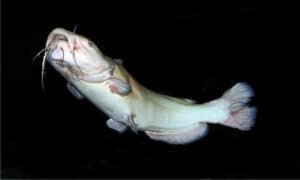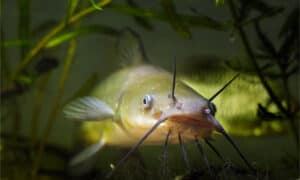Freshwater catfish make popular additions to many tropical aquariums. They are generally known for their cleaning abilities by feeding on leftover food, rotting plants, and sometimes even green algae. Whether you are looking for a small catfish or a large catfish to liven up your freshwater aquarium, this article will discuss 10 species of catfish that are worth considering.

1. Pygmy Corydoras

As its name suggests, pygmy
Corydorasis the smallest cory catfish, measuring only 1 inch long.
©Pavaphon Supanantananont/Shutterstock.com
Corydoras are some of the most popular catfish kept in aquariums. The pygmy (or dwarf) Corydoras have the same fascinating qualities as standard-sized ones, except they don’t grow as big. This makes them the perfect addition to smaller aquariums. Pygmy catfish grow to a maximum size of around 0.75 to one inch. The females are typically larger than the males, although their adult sizes are relatively the same. Although it’s uncommon, some pygmy Corydoras can reach 1.5 inches in size.
Pygmy Corydoras are peaceful fish originating from the tropical waters of South America. They have a dark stripe that runs from their snout to their caudal fin, with small barbels underneath their mouths. These small catfish usually have a slightly transparent tan coloration with their dark black stripe being their most distinctive feature. Pygmy Corydoras are highly social and benefit from being kept in groups of six or more.
They spend most of their time at the bottom of the aquarium foraging for food and socializing with each other. In the right conditions, pygmy catfish are active and rarely spend their time hiding. This makes them fun to watch and liven up the bottom area of tropical freshwater aquariums.
2. Pictus Catfish
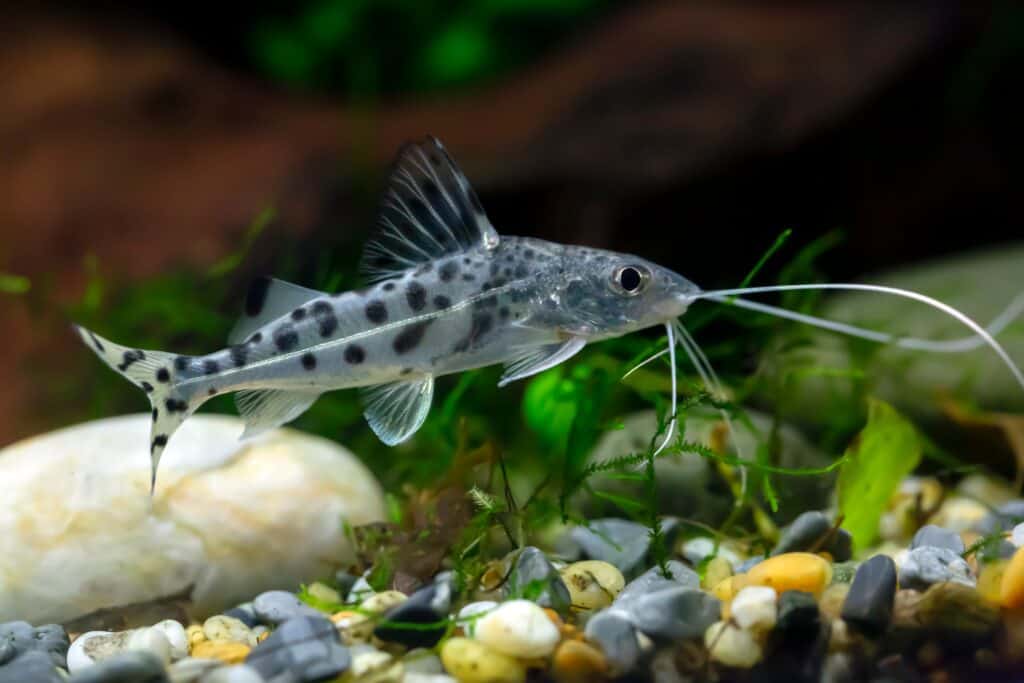
The pictus catfish are peaceful and medium-sized catfish.
©boban_nz/Shutterstock.com
Pictus catfish have been great additions to aquariums for decades. Their peaceful yet timid temperament makes them ideal for community aquariums. They originate from the Orinoco and Amazon River Basins in South America, but they are popular in the aquarium trade industry. These freshwater catfish grow to an adult size of 3.5 to 5 inches, and it is uncommon for them to grow larger than this. Pictus catfish have a silverish color with uneven spotting. They have long barbels that frame their face and a black or striped dorsal fin.
In an aquarium, pictus catfish should be housed in groups since they are naturally social fish. Due to their size, they should be housed in larger tropical aquariums than some of the smaller species of catfish. When kept in a proper setup and in groups, they rarely hide and enjoy interacting at the bottom of the aquarium. They have a long lifespan between eight to 10 years in captivity, so they can make fascinating additions to aquariums for up to a decade.
3. Bristlenose Plecostomus
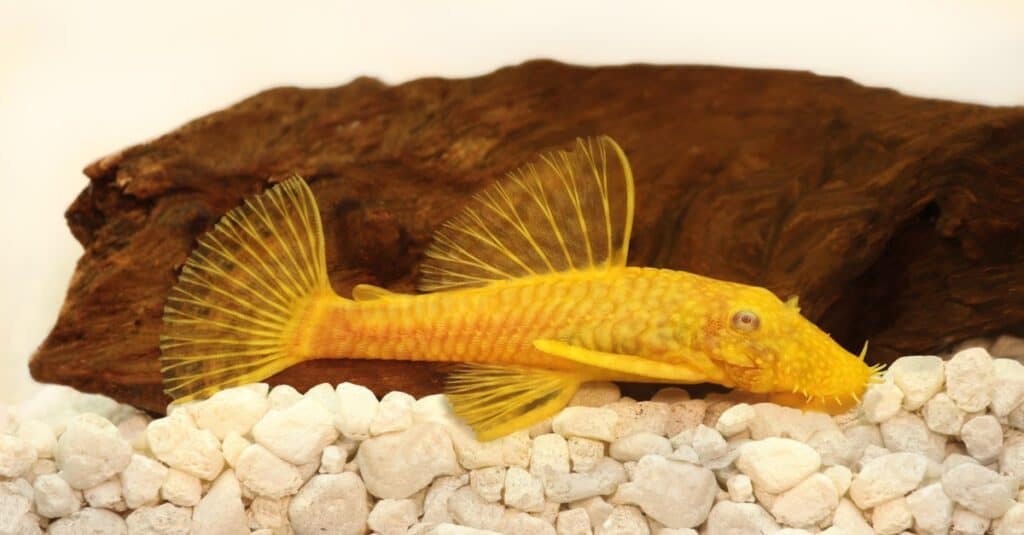
The bristlenose pleco is popular among the smallest pleco fish.
©iStock.com/Mirko_Rosenau
If you don’t have the space for larger species of pleco but you enjoy the species, then the bristlenose pleco is a good choice. These are medium-sized catfish that typically reach a size of 5 inches. They naturally populate in South American waters, but they also make popular additions to aquariums. One of their most defining features is their cluster of bushy tentacles around their heads. These tentacles are most visible in older males and look striking with their dark coloration. However, bristlenose pleco’s are available in lighter color forms like yellow or orange.
Unlike many other types of catfish, bristlenose pleco’s can be housed alone, and males become territorial of each other when they are older. They don’t crave companionship and generally keep to themselves in community tanks. With proper care, bristlenose pleco’s have an average lifespan of 10 to 12 years.
4. Gold Nugget Plecostomus
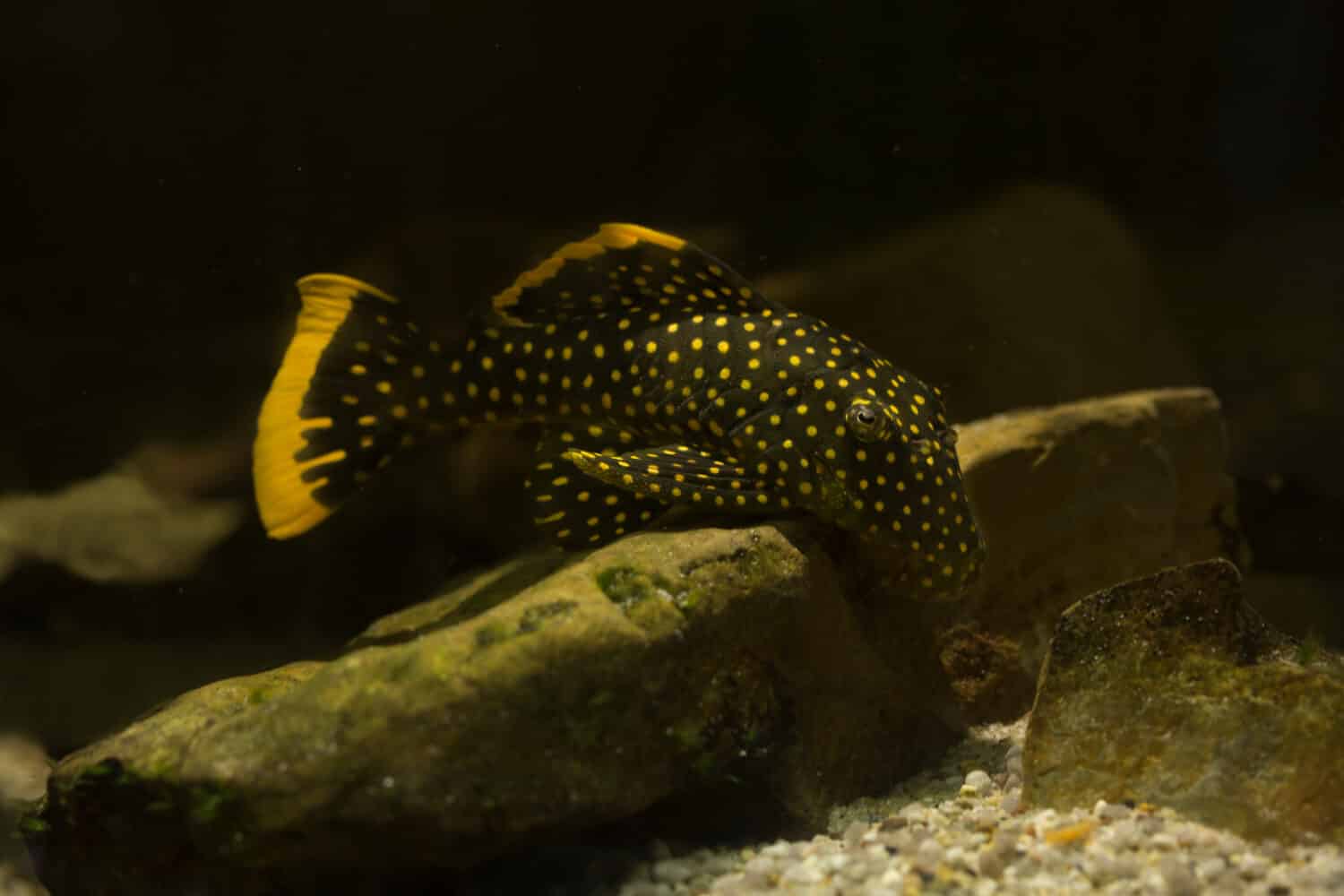
The pleco has a suckermouth that allows them to attach themselves to surfaces in aquariums.
©Podolnaya Elena/Shutterstock.com
If you are looking for a beautifully colored pleco to add to your freshwater aquarium, gold nugget plecos are an excellent choice. These plecos have a vivid yellow coloration at the ends of their fins, and their bodies are dark black with striking white spots. Gold nugget plecos can grow between 6 to 10 inches in captivity, so they are better suited for larger aquariums. They should also be housed alone since they are solitary fish.
Gold nugget pleco usually inhabits the bottom of the aquarium, but they will attach themselves to the glass, plant leaves, rocks, wood, and filters using their suckermouth. They are mostly active at night and enjoy searching for food on various surfaces in the aquarium.
5. Albino Corydoras

All
Corycatfish should have smooth sand or gravel for substrate, so they don’t damage their barbels.
©JuanCarlosPalauDiaz/Shutterstock.com
A Corydoras that has a light coloration is the albino Corydoras. They reach an adult size of three inches, although males are smaller at around 2.5 inches in length. Their bodies lack the typical color pigment found in other varieties of Corydoras, allowing them to stand out against dark substrates.
Their bodies are a creamy tan color with red eyes and gills. Like most Corydoras, the albino Corydoras is a social fish that enjoys being kept in groups of six or more. Keeping them together in medium-sized freshwater aquariums allows them to be active and spend most of their time interacting and foraging for food. Albino corydora can form part of the aquarium clean-up crew and they help retrieve leftover fish food from the substrate that would otherwise cause water quality issues.
6. Otocinclus
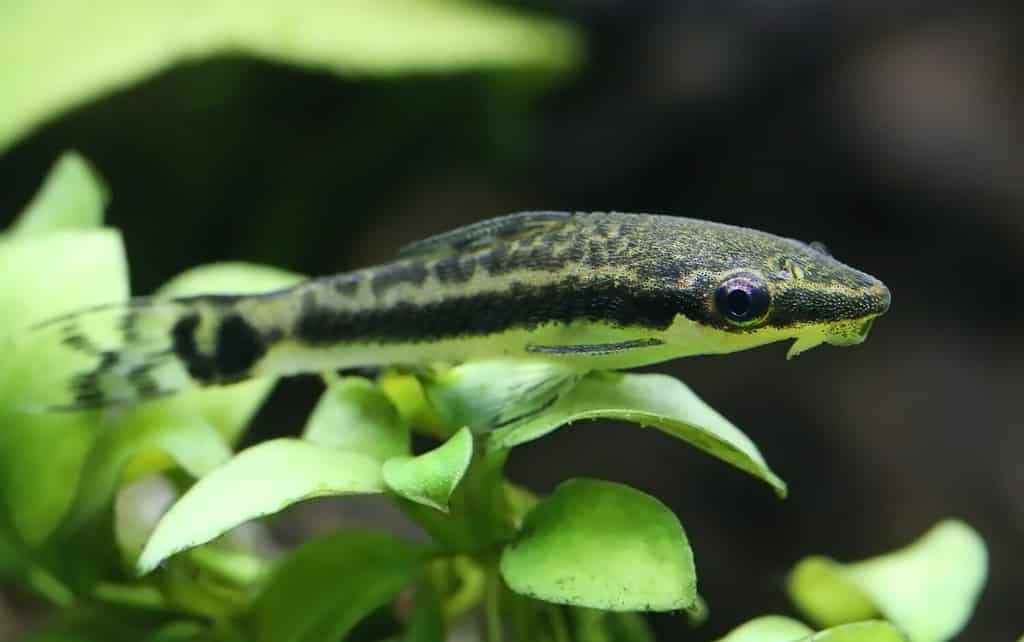
catfish are small and can be kept in small to medium-sized aquariums.
©Swapan Photography/Shutterstock.com
A small species of catfish that is ideal for small freshwater aquariums is the Otocinclus (or “oto” for short). They originate from tropical South American waters and are social fish that like to be kept in groups. It is recommended to keep between five to six Oto catfish together to encourage social behaviors and activity in an aquarium.
They only grow to a maximum of 2 inches in size, which isn’t very large. Their slender bodies have a standard brown or grey color with dark black striped, and their fins can sometimes appear semi-transparent. Oto catfish are great algae eaters, so their peaceful temperaments and cleanup abilities make them a vital part of a tank’s cleanup crew.
Although Oto catfish can be active, they may spend a bit more time hiding amongst the aquarium’s rocks and plants. With proper care, Oto catfish can live for around three to five years, which isn’t as long as many other catfish.
7. Banjo Catfish

An interesting species of catfish would be the banjo catfish from South America. These types of catfish have long and slender tails while only growing a size of 6 inches in captivity. Banjo catfish are primarily solitary fish as adults, so you only need to keep one of them in a medium to large-sized aquarium. Thanks to their peaceful temperaments, banjo catfish can be kept in tropical community aquariums or singularly. They rarely interact with other fish and prefer to keep to themselves. Banjo catfish can be found in various color forms, such as black, brown, yellow, and grey, or a combination of these colors.
Although banjo catfish can blend into aquarium substrate quite well, they usually become most active during feeding time. With proper care, banjo catfish have the ability to live for up ten years. These catfish are relatively simple to feed, and they enjoy eating omnivorous foods that sink to the bottom of the aquarium.
8. Striped Raphael Catfish

The striped Raphael catfish has a thick body with yellowish stripes on either side.
©chonlasub woravichan/Shutterstock.com
Striped Raphael catfish are large, freshwater fish that are known for their peaceful temperaments. They originate from the Amazon and Orinoco River Basins in South America and inhabit tropical freshwater conditions. The striped Raphael catfish generally grows between 8 to 10 inches in size and have a black or dark brown body.
Their main distinctive feature is thick yellow or white stripes on either side of their bodies. They also have barbels underneath their mouths which become more prominent as they age. These catfish are relatively hardy and easy to care for. However, it is important that their aquarium’s water conditions are kept filtered and maintained to contain no ammonia or nitrites. Striped Raphael catfish enjoy foraging in aquariums for leftover food and decaying plants, although they aren’t the most active catfish.
They are relatively social fish and can be kept in small groups. Due to their large size, most striped Raphael catfish require a large fish tank if they are kept together.
9. Bumblebee Catfish
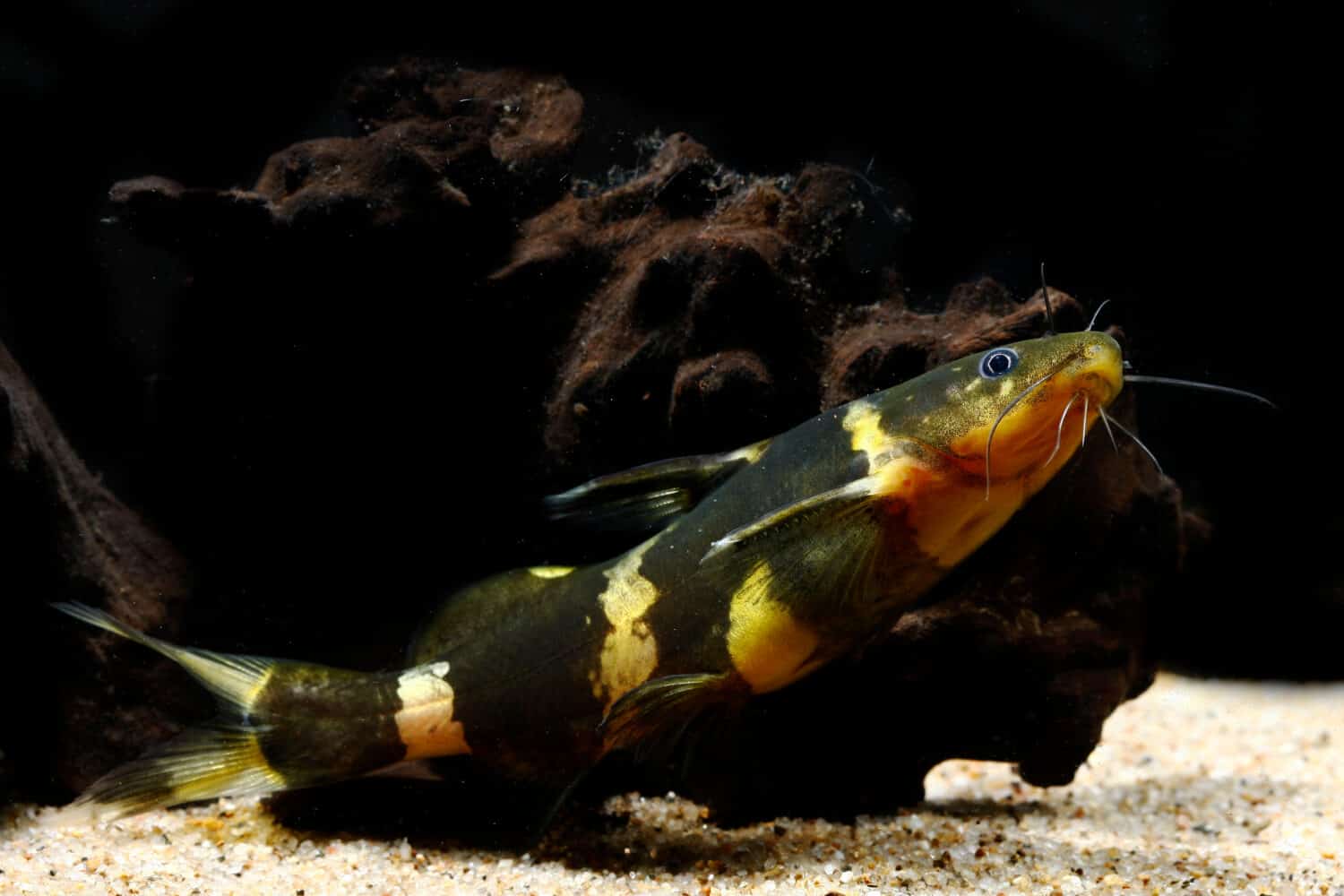
The bumblebee catfish is social and enjoy being kept in groups.
©Pavaphon Supanantananont/Shutterstock.com
If you are looking for unique-looking catfish that is entertaining to watch, then the bumblebee catfish is a top choice. These small catfish grow between 2-3 inches in size, making them ideal for medium-sized tanks. Bumblebee catfish are considered easy to care for and thrive in tropical freshwater aquariums.
They have a slender-shaped body with distinctive yellow and dark brown or black banding that makes them look like bumblebees. Bumblebee catfish are mostly active during the night, but low-lit aquariums can sometimes encourage them to be more active during the early mornings and evenings. Their temperament is often described as timid yet peaceful. The bumblebee catfish is an omnivore and should be fed a staple pelleted or commercial food, but they will eat any leftover food in the substrate from other fish.
As naturally social fish, the bumblebee catfish should be kept in same-specie groups. Keeping them in groups seems to amplify their activity levels in the aquarium. When cared for properly, bumblebee catfish can live for around five years.
10. Upside Down Catfish
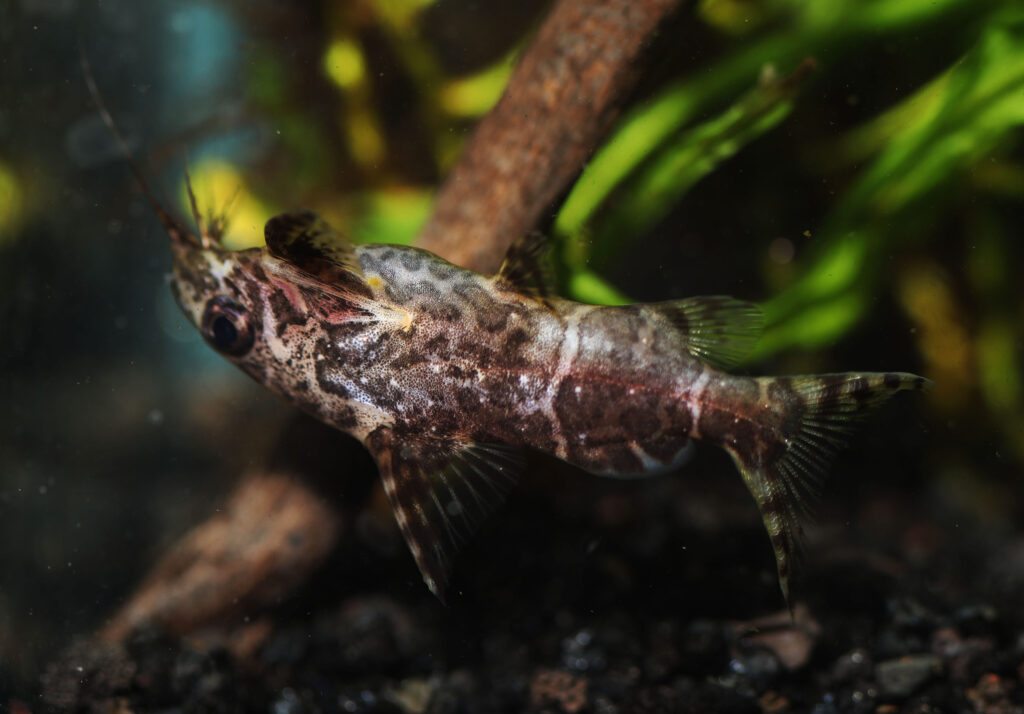
These fish don’t just
lookupside-down. They actually swim upside-down!
©Pavaphon Supanantananont/Shutterstock.com
Our last highly recommended freshwater catfish to liven up your aquarium is the upside-down catfish. Upside down catfish have an unusual swimming posture that allows them to feed from the surface of the water. They swim with their bellies up, which is quite interesting to watch. The upside-down catfish reaches an adult size of 3 to 4 inches in captivity and can be found in several different color forms.
Most upside-down catfish is a muddy brown or tan coloration with dark bellies. However, they can have a splotchy yellow and dark brown color or appear as if they have tiger-like markings. Some upside-down catfish can also be a light tank color with striking spots.
The upside-down catfish is generally peaceful and suitable for communities, but they can be difficult to spot during the day. Upside-down catfish usually spend most of their time hiding until their activity levels spike at night. As a social catfish, the upside-down catfish should be kept in groups of four or more. In some cases, they can become territorial as they mature and enjoy having enough space for a short break away from their group.
Summary of the 10 Freshwater Catfish to Liven Up Your Aquarium
| Rank | Freshwater Catfish |
|---|---|
| 1 | Pygmy corydoras |
| 2 | Pictus catfish |
| 3 | Bristlenose Plecostomus |
| 4 | Gold nugget Plecostomus |
| 5 | Striped Raphael catfish |
| 6 | Otocinclus |
| 7 | Banjo catfish |
| 8 | Striped Raphael catfish |
| 9 | Bumblebee catfish |
| 10 | Upside down catfish |
The photo featured at the top of this post is © boban_nz/Shutterstock.com
Thank you for reading! Have some feedback for us? Contact the AZ Animals editorial team.





